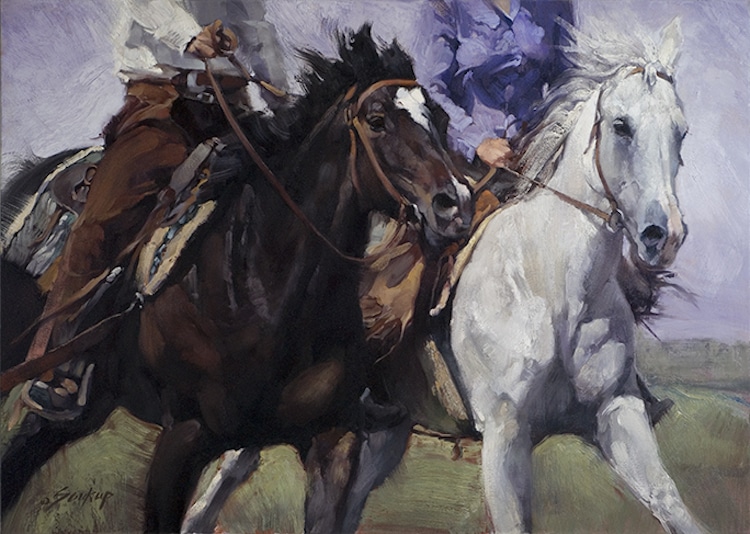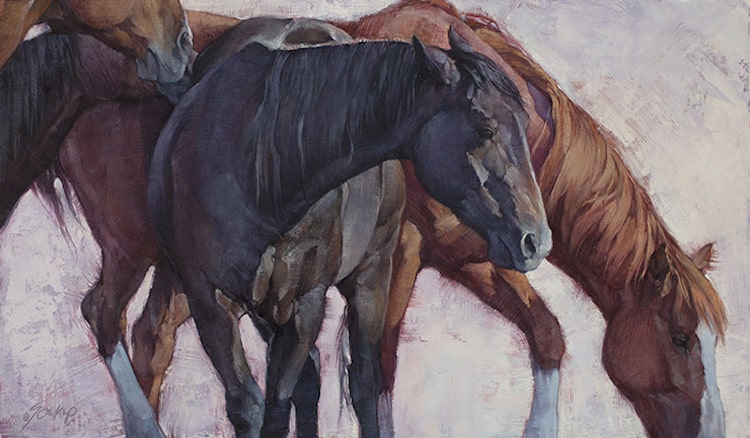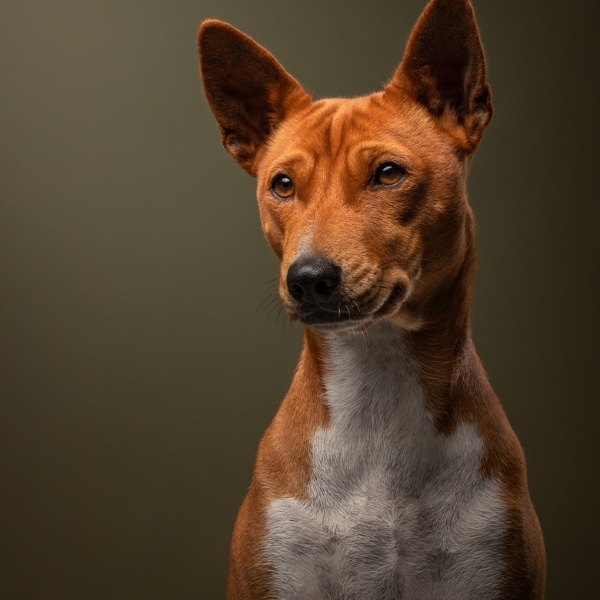
Orange & Purple Cluster
Driven by a lifelong love of horses, Jill Soukup has made a name for herself as a well-known Western painter. The Colorado-based artist has developed an unexpectedly expressive style that enables her to capture “the richly kinetic moments that define Western ranch life.” While this painterly treatment has proven effective on a range of ranch-themed subjects, it is particularly striking when paired with horses, as evident in Soukup's Equine series.
Equine offers viewers a glimpse into Soukup's specialty: painting horses. Rendered in Soukup's signature loose brushstrokes and vibrant yet lifelike use of color, these equine portraits are both evocative and energetic, showing a side to the animals not many of us have had the chance to explore.
Though the paintings are unified by both their subjects and style, Soukup successfully keeps the viewers' attention by playing with poses, composition, and, most interestingly, an attention to contrast. “The intent of my work is to capture the balance that exists at the intersection of opposite elements and to expose underlying similarities in things that are perceived to be fundamentally different,” she says. “I’m driven by the process of painting contrasts, and by pushing value, color, and texture in a realistic setting.”
With such an eye-catching approach to animal portraiture, it's no wonder that Soukup has seen such success as an artist. In order to learn more about both her Equine series and her practice as a whole, we recently spoke to Soukup. Read My Modern Met’s exclusive interview below.

Cool Down
You’ve admitted to having a fascination with horses since you were a young girl. What first attracted you to the horse as an artistic subject?
Mostly that I wanted a real horse and couldn't. Thus, drawing and sculpting them was almost like touching and having the real thing.
Early in your career, you worked as a pet portraitist. Have any other animals captured your attention quite like horses?
Nothing is quite like the horse. In my mind, they are proportionally perfect. And as I've spent more time with them over the years—thanks to my relationship with Ranchlands (I attend their artist gatherings and teach there)—I continue to find deeper appreciation and meaning in observing, recording, and just being around them.

Cuddle
Later on, you pursued illustration and graphic design. Have these disciplines influenced your current work at all?
Yes, most definitely! Working as a commercial artist taught me boundaries. Artistically, there were specific requirements with each project that set the tone. One might think that would be restrictive, but too many choices can be overwhelming. Even with boundaries, the choices are limitless, but they are more directed.
As a painter, I have very clear intentions (the parameters) such as the color scheme and knowing how I want the viewer to move through a canvas. Professionally, I learned about deadlines and teamwork—two skills of which have been invaluable as a fine artist with my teaching and with my gallery relationships.

Dashing Dandy
Your practice largely revolves around the “process of painting contrasts.” How has this approach informed your Equine series?
It’s perhaps the other way around, that painting horses has informed what I’ve been exploring with contrasts. For example, I’ve had an ongoing series learning about the contrasts between a dark colored horse adjacent to a light one. I would be exploring contrasts regardless of the subject (I used to do a lot of architectural themes); but my relationship with Ranchlands steered me to paint more horses (and the Ranch in general).
This led to one particular Western themed exhibition which led to more Western exhibitions and an invitation into galleries that primarily sold Western work. So I fell into painting horses professionally sort of by accident. The art principles are the same—it’s just that my vehicle transferred from the architectural to the equine.

Stride for Stride
How do you capture the horses’ personalities in your works?
I get asked that a lot and I honestly don’t know. When I paint I’m focused on the abstract components that make up a representational image. I’m thinking, “Oh, that shape is round, blue, dull, etc.” for example. Perhaps I’m just recording those shapes accurately from my references. There are also the intuitive, unarticulated choices. I like to think these come from a higher consciousness or metaphysical place. Perhaps It’s simply that I have always loved horses.

Blue Itch
You now work as both a full-time parent and a practicing painter. Do you have any advice for others trying to balance these two roles?
It’s definitely a balancing act and it’s hard, but becoming a parent was the best decision of my life. It’s funny, your life becomes more complex but you get better at simplifying the components of your life. Your time becomes particularly prized. I got very efficient on my “Mommy Days.” There is no messing around. I have a set amount of time to paint, so I make quicker and better decisions. It’s so easy to mull things over and go back and forth on a painting, but being a parent changed that.
I also got better at saying “no” and accepting to do only the events that meet my career goals. It’s made me a more patient, balanced, and less selfish person. My son is older now so it’s all easier but I have amazing family support. My husband is an amazing father and his parents help out one or two days a week. They are all cheerleaders for my “habbit” (Ha!).

Dark Passages
Do you have any upcoming plans or projects?
Yes! I have a two-person show with Teresa Elliott at Gallery 1261 in Denver. The opening is October 5 and it runs through October 26.

Orange Repose

Gray’dations

Hold Steady

Four Horse Bundle

White Marsh March

Gang of Five
Jill Soukup: Website | Facebook | Instagram
My Modern Met granted permission to feature photos by Jill Soukup.
Related Articles:
Photographer Captures the Wild Beauty and Elegance of Horses
Interview: Expressive Paintings of Native Americans in Authentic Dress
Artist Uses Thick Brushstrokes to Create Paintings of Plump Songbirds






















































































